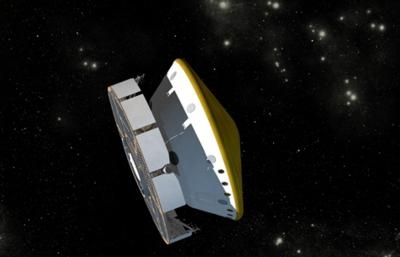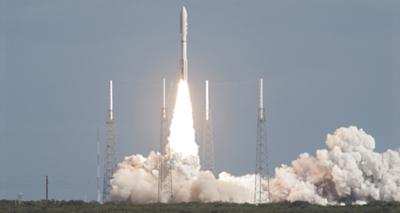Mon, Jan 09, 2012
Spacecraft To Fire Thrusters To Re-Direct Spacecraft Closer To
Mars
An engine firing on January 11 will be the biggest maneuver that
NASA's Mars Science Laboratory spacecraft will perform on its
flight between Earth and Mars.

The action will use a choreographed sequence of firings of eight
thruster engines during a period of about 175 minutes beginning at
2300 UCT. It will redirect the spacecraft more precisely toward
Mars to land at Gale Crater. The trajectory resulting from the
mission's November 26, 2011, launch intentionally misses Mars to
prevent the upper stage of the launch vehicle from hitting the
planet. That upper stage was not cleaned the way the spacecraft
itself was to protect Mars from Earth's microbes.
The maneuver is designed to impart a velocity change of about 12.3
miles per hour (5.5 meters per second).
"We are well into cruise operations, with a well-behaved spacecraft
safely on its way to Mars," said Mars Science Laboratory Cruise
Mission Manager Arthur Amador, of NASA's Jet Propulsion Laboratory,
Pasadena, CA. "After this trajectory correction maneuver, we expect
to be very close to where we ultimately need to be for our entry
point at the top of the Martian atmosphere."
The mission's schedule before arrival at Mars on August 5 includes
opportunities for five more flight path correction maneuvers, as
needed, for fine tuning.
The January 11th maneuver has been planned to use the spacecraft's
inertial measurement unit to measure the spacecraft's orientation
and acceleration during the maneuver. A calibration maneuver using
the gyroscope-containing inertial measurement unit was completed
successfully on Dec. 21. The inertial measurement unit is used as
an alternative to the spacecraft's onboard celestial navigation
system due to an earlier computer reset.
Diagnostic work continues in response to the reset triggered by
use of star-identifying software on the spacecraft on November 29.
In tests at JPL, that behavior has been reproduced a few times out
of thousands of test runs on a duplicate of the spacecraft's
computer, but no resets were triggered during similar testing on
another duplicate. The spacecraft itself has redundant main
computers. While the spacecraft is operating on the "A side"
computer, engineers are beginning test runs of the star-identifying
software on the redundant "B side" computer to check whether it is
susceptible to the same reset behavior.

The Mars Science Laboratory mission will use its car-size rover,
Curiosity, to investigate whether the selected region on Mars
inside Gale Crater has offered environmental conditions favorable
for supporting microbial life and favorable for preserving clues
about whether life existed. On January 15, the spacecraft
operations team will begin a set of engineering checkouts. The
testing will last about a week and include tests of several
components of the system for landing the rover on Mars and for the
rover's communication with Mars orbiters.
The spacecraft's cruise-stage solar array is producing 780 watts.
The telecommunications rate is 2 kilobits per second for uplink and
downlink. The spacecraft is spinning at 2.04 rotations per minute.
The Radiation Assessment Detector, one of 10 science instruments on
the rover, is collecting science data about the interplanetary
radiation environment.
As of 1700 UCT on Saturday, January 7, the spacecraft will have
traveled 72.9 million miles of its 352-million-mile flight to Mars.
It will be moving at about 9,500 mph relative to Earth and at about
69,500 mph relative to the sun. (Images provided by NASA)
More News
Aero Linx: International Federation of Airworthiness (IFA) We aim to be the most internationally respected independent authority on the subject of Airworthiness. IFA uniquely combi>[...]
Ultrahigh Frequency (UHF) The frequency band between 300 and 3,000 MHz. The bank of radio frequencies used for military air/ground voice communications. In some instances this may >[...]
A Few Questions AND Answers To Help You Get MORE Out of ANN! 1) I forgot my password. How do I find it? 1) Easy... click here and give us your e-mail address--we'll send it to you >[...]
From 2019 (YouTube Edition): Learning To Paint Without Getting Any On Your Hands PPG's Aerospace Coatings Academy is a tool designed to teach everything one needs to know about all>[...]
Also: Sustainable Aircraft Test Put Aside, More Falcon 9 Ops, Wyoming ANG Rescue, Oreo Cookie Into Orbit Joby Aviation has reason to celebrate, recently completing its first full t>[...]
 ANN's Daily Aero-Linx (05.06.25)
ANN's Daily Aero-Linx (05.06.25) ANN's Daily Aero-Term (05.06.25): Ultrahigh Frequency (UHF)
ANN's Daily Aero-Term (05.06.25): Ultrahigh Frequency (UHF) ANN FAQ: Q&A 101
ANN FAQ: Q&A 101 Classic Aero-TV: Virtual Reality Painting--PPG Leverages Technology for Training
Classic Aero-TV: Virtual Reality Painting--PPG Leverages Technology for Training Airborne 05.02.25: Joby Crewed Milestone, Diamond Club, Canadian Pilot Insurance
Airborne 05.02.25: Joby Crewed Milestone, Diamond Club, Canadian Pilot Insurance




